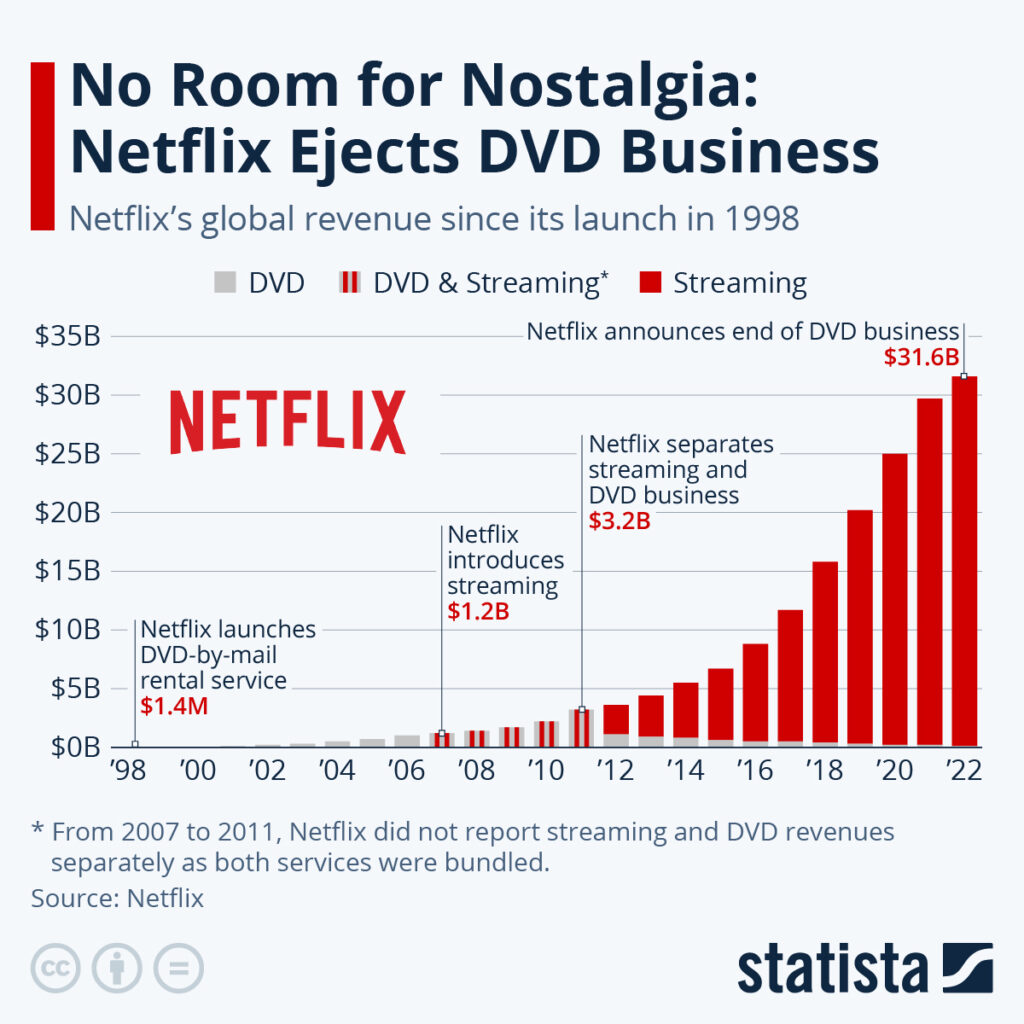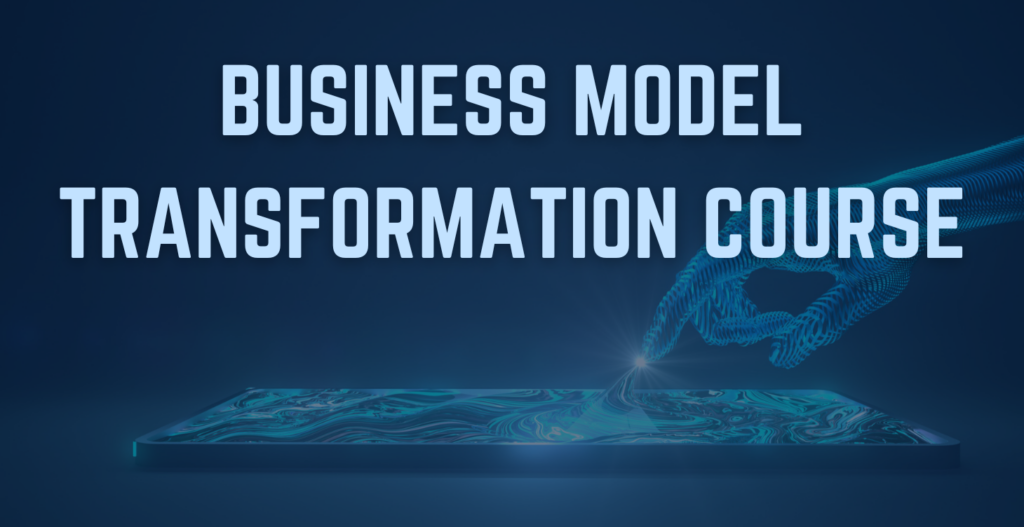
Radical Business Model Transformation
In an era where change is the only constant, businesses are increasingly challenged to rethink their foundational strategies to thrive. This ushers in the concept of Radical Business Model Transformation, a critical strategy for organisations aiming to navigate the turbulent waters of modern markets.
Unlike incremental modifications that aim to refine and improve, radical transformation demands a deep, foundational reshaping of how a company operates. Its significance is magnified in today's dynamic business environment, where technological advancements, market shifts, and evolving consumer preferences can render traditional business models obsolete overnight.
Certified Business Model Transformation Practitioner
What is Radical Business Model Transformation?
Radical Business Model Transformation involves a profound overhaul of a company’s core mechanisms for creating, delivering, and capturing value. This transformative process goes beyond mere adjustments or improvements to existing models; it requires envisioning a completely new way of conducting business that can respond to or anticipate market disruptions.
This type of transformation is essential for organisations facing significant industry shifts, emerging technological landscapes, or changing global economic conditions. By adopting radical changes, companies can unlock new growth avenues, foster innovation, and maintain relevancy in an ever-evolving marketplace.
The importance of embarking on such transformative journeys lies in their potential to not just sustain but propel businesses forward, allowing them to redefine industry standards and create unparalleled value for their customers.
As we delve into the nuances of radical business model transformation, we aim to uncover the catalysts prompting such shifts, explore the strategies for successful implementation, and highlight real-world examples of companies that have navigated this complex process successfully.
This article will serve as a guide for business leaders and innovators seeking to understand and leverage radical business model transformation as a tool for strategic renewal and competitive advantage.
The Need for Radical Business Model Transformation
The landscape of business is perpetually in flux, driven by a confluence of factors that demand organisations to reconsider and radically alter their business models. The urgency for such transformative change is propelled by several key forces, each interplaying to shape the future of industries worldwide.
Driving Forces Behind Radical Change
Technological Advancements
The rapid pace of technological innovation is perhaps the most significant catalyst for radical transformation. Breakthroughs in AI, blockchain, IoT, and other digital technologies are redefining what's possible, enabling new business models and disrupting established ones.
Market Shifts
Globalisation and the digitisation of economies have led to broader market shifts, including the emergence of new markets and the obsolescence of others. These shifts require businesses to adapt quickly or face irrelevance.
Competitive Pressures
The entry of agile startups and the blurring of industry boundaries due to digital platforms increase competitive pressures on traditional businesses. Companies are now compelled to innovate not just for growth but for survival.
Evolving Consumer Expectations
Today's consumers demand more personalised, on-demand, and ethically produced goods and services. Meeting these expectations often requires a fundamental rethink of how businesses operate and engage with their customers.
Consequences of Failing to Adapt
The repercussions of overlooking the need for radical business model transformation can be dire and, in many cases, terminal for organisations. These consequences manifest in various ways:
Loss of Market Relevance
Companies that fail to keep pace with market evolution risk losing their place to more innovative and adaptable competitors, resulting in diminished market share and relevance.
Reduced Competitive Edge
Without innovation, businesses struggle to differentiate themselves in crowded markets, leading to price wars, reduced margins, and ultimately, a weakened competitive position.
Operational Inefficiencies
Sticking to outdated business models can lead to operational inefficiencies, preventing organisations from leveraging new technologies that could streamline operations and reduce costs.
Missed Opportunities
By not embracing radical transformation, companies miss out on the opportunity to lead new markets, set industry standards, and capitalise on emerging consumer trends.
The failure to pursue radical business model transformation is not merely a missed opportunity for growth; it's a step towards obsolescence. As such, understanding and responding to the driving forces behind the need for such change is not optional but essential for any organisation looking to thrive in the modern business ecosystem.
Characteristics of Radical Business Model Transformation
Radical business model transformation sets itself apart from incremental changes through a series of distinct, defining features. These transformations are comprehensive, touching every aspect of the organisation and leading to fundamentally different ways of operating. Understanding these characteristics is crucial for businesses aiming to undertake such a transformative journey.
Complete Overhaul of Value Propositions
One of the hallmarks of radical business model transformation is the redefinition of the organisation's value proposition. Unlike incremental changes that might slightly adjust the benefits offered to customers, radical transformations often involve creating entirely new value propositions that address emerging customer needs, exploit new technologies, or respond to changes in the competitive landscape. This could mean shifting from product sales to service subscriptions, focusing on sustainability and ethical production, or leveraging digital platforms to offer personalised experiences.
Transformation of Revenue Streams
Radically transforming a business model typically involves rethinking how the organisation generates revenue. Traditional revenue models may be replaced or supplemented with innovative strategies that better align with the new value proposition and operational model. For example, companies might shift from one-time sales to recurring revenue models, adopt a freemium strategy to expand their customer base, or leverage data and analytics to introduce dynamic pricing models. This shift in revenue streams is often fundamental to sustaining the new business model and supporting long-term growth.
Redefinition of Operational Processes
Radical business model transformation requires a comprehensive re-evaluation and redesign of operational processes. This redefinition goes beyond optimising existing procedures for efficiency; it involves reimagining how products or services are developed, produced, and delivered to match the new business model. Such transformations might include adopting agile development methodologies, leveraging automation and AI to streamline operations, or reconfiguring supply chains for greater flexibility and responsiveness. The aim is to create operational processes that are not only more efficient but also more adaptable to the fast-paced changes in the market and technology.
Shift in Organisational Structure and Culture
Fundamental to supporting the new value propositions, revenue models, and operational processes is a corresponding shift in organisational structure and culture. Radical business model transformation often requires breaking down silos, fostering cross-functional collaboration, and cultivating a culture of innovation and agility. This cultural shift is critical for empowering employees, encouraging experimentation, and enabling the organisation to respond swiftly to opportunities and challenges.
Understanding these characteristics of radical business model transformation can help organisations appreciate the scope and depth of change required. It's a journey that demands bold leadership, a clear vision, and a willingness to challenge the status quo, but the potential rewards in terms of growth, competitiveness, and relevance in the digital age are substantial.
Challenges and Barriers
Embarking on a journey of radical business model transformation is fraught with challenges and barriers. Understanding these obstacles is the first step toward navigating them successfully. Let's delve into some of the most common issues organisations face and explore strategies for overcoming these hurdles.
Common Obstacles to Radical Business Model Transformation
Internal Resistance
One of the most significant challenges is resistance from within the organisation. Employees and sometimes even management may resist changes due to fear of the unknown, potential loss of job security, or simply a preference for the status quo. This resistance can slow down or even derail transformation efforts.
Cultural Inertia
An organisation's culture—its values, beliefs, and behaviours—can be a formidable barrier to radical change. Cultures that value tradition over innovation or are risk-averse may struggle to adapt to new business models that require agility and a willingness to experiment and fail.
Resource Constraints
Radical transformation often requires significant investment in new technologies, skills, and processes. Organisations may face constraints related to finances, time, or human capital, making it challenging to allocate the necessary resources to support transformation initiatives.
Overcoming Challenges
Fostering a Culture of Change
To overcome internal resistance and cultural inertia, leadership must actively work to foster a culture that embraces change and innovation. This can involve clear and consistent communication about the benefits and importance of the transformation, offering training and development to equip employees with new skills, and creating a safe environment for experimentation and learning from failures.
Engaging Employees in the Transformation Process
Involving employees at all levels in the transformation process can help mitigate resistance. This engagement can take the form of collaborative ideation sessions, innovation labs, or pilot projects that allow employees to contribute to and have a stake in the outcome of the transformation.
Strategic Resource Allocation
Addressing resource constraints requires strategic planning and prioritisation. Organisations might need to reallocate budgets, explore partnerships or alternative funding sources, or phase the transformation process to manage costs effectively. Leveraging existing resources creatively and focusing on high-impact areas can also help overcome financial and human capital limitations.
Leadership and Vision
Strong leadership is crucial for navigating the challenges of radical transformation. Leaders must provide a clear vision, demonstrate commitment to the transformation, and inspire confidence and resilience within the organisation. Leading by example and maintaining an open line of communication can help align the organisation's efforts and maintain momentum through the transformation journey.
Overcoming the challenges associated with radical business model transformation is no small feat. However, by understanding and addressing these obstacles head-on, organisations can enhance their capacity to innovate and thrive in an ever-changing business environment. The keys to success lie in fostering a culture of change, engaging, and empowering employees, strategically managing resources, and demonstrating strong, visionary leadership.
Strategies for Implementing Radical Change
Implementing radical business model transformation is a complex and multifaceted endeavour that demands a structured and strategic approach. Here’s a step-by-step guide designed to navigate organisations through the process of executing profound changes, highlighting the critical roles of leadership, a culture of innovation, and a focus on customer-centricity.
Step-by-Step Approach for Radical Transformation
Step 1: Establish Clear Leadership and Vision
Successful transformation begins with visionary leadership. Leaders must clearly articulate the need for change, the vision for the future, and the values that will guide the transformation process. This vision serves as a north star, providing direction and inspiring commitment throughout the organisation.
Step 2: Cultivate an Innovation Culture
Building a culture that embraces innovation is crucial. Encourage creativity, risk-taking, and learning from failures. Recognise and reward innovative ideas and efforts, even if they don't always lead to success. An environment that supports innovation at all levels paves the way for transformative changes.
Step 3: Foster Customer-Centricity
Deeply understanding customer needs, preferences, and pain points is essential. Engage with customers through research, feedback, and direct interactions to gain insights that will inform the transformation. Design your new business model with a laser focus on delivering superior value and experiences to customers.
Step 4: Conduct Thorough Market and Internal Analysis
Analyse market trends, competitive landscape, and internal capabilities to identify opportunities and threats. This analysis will help pinpoint areas for innovation and guide strategic decisions regarding which aspects of the business model to transform.
Step 5: Prototype and Pilot New Business Models
Before a full-scale rollout, prototype new business model concepts and test them through pilot projects. This approach allows for real-world experimentation and learning, reducing risks associated with radical change.
Step 6: Implement Agile Methodologies
Adopt agile methodologies to enhance flexibility and responsiveness. Agile practices support rapid iteration, enabling the organisation to adapt quickly based on feedback and emerging insights during the transformation process.
Step 7: Scale and Integrate Successful Innovations
Once pilot projects validate the viability of the new business model, begin scaling these innovations across the organisation. Ensure integration with existing operations to maintain coherence and synergy.
Role of Experimentation, Prototyping, and Agile Methodologies
Experimentation and Prototyping
Experimentation allows organisations to test hypotheses about new business models in a controlled, low-risk environment. Prototyping, whether for products, services, or operational processes, provides tangible insights into how theoretical concepts perform in practice. These strategies are invaluable for refining and validating the components of a radical transformation before full implementation.
Agile Methodologies
Agile methodologies play a crucial role in facilitating radical change by emphasising adaptability and continuous improvement. By breaking down the transformation process into smaller, manageable increments, agile approaches enable organisations to respond swiftly to challenges and opportunities as they arise. This flexibility is particularly beneficial in the context of radical transformation, where the outcome and path forward may not be entirely predictable.
Incorporating these strategies into the process of implementing radical business model transformation can significantly enhance an organisation's ability to navigate the complexities of change successfully. Leadership, innovation culture, customer-centricity, experimentation, and agility form the pillars upon which transformative efforts can be built and sustained, driving organisations towards a future of renewed potential and competitive advantage.
Case Studies of Successful Transformations
The journey of radical business model transformation is best illustrated through the successes of companies that have navigated this challenging process. These case studies not only showcase the potential rewards of such transformations but also offer valuable lessons for other organisations contemplating similar changes.
Transforming Adobe: From Software Sales to Subscription Services
Adobe faced the challenge of software piracy, declining revenues from one-time software sales, and the need for a more predictable revenue stream.
Strategy
Adobe shifted from selling perpetual software licenses to a subscription-based model with the launch of Adobe Creative Cloud in 2013.
Execution
This transition involved overhauling Adobe's product development, sales strategy, and customer support to focus on cloud-based services, offering regular updates, and enhancing user collaboration.
Outcome
Adobe's transformation led to a significant increase in recurring revenue, expanded customer base, and solidified its position as a leader in creative software services. The company's stock price and market valuation soared as it successfully transitioned to a SaaS model.
Lessons and Insights
Adobe's success underscores the importance of aligning business models with evolving market conditions and consumer preferences. Their willingness to disrupt their own sales model for long-term gain demonstrates the value of strategic foresight and customer-centric innovation.
IKEA: Embracing Omni-Channel Retailing
With changing consumer shopping habits and the rise of e-commerce, IKEA needed to integrate its in-store and online shopping experiences to remain competitive.
Strategy
IKEA adopted an omni-channel approach, enhancing its online presence and integrating digital tools with physical stores to create a seamless customer journey.
Execution
The company developed a robust e-commerce platform, introduced AR tools for virtual furniture placement, and improved logistical operations for online order fulfilment.
Outcome
IKEA's omni-channel strategy led to increased sales both online and in-store, improved customer satisfaction through enhanced shopping experiences, and strengthened its market position as a leading home furnishings retailer.

Lessons and Insights
IKEA's transformation highlights the power of embracing technology to meet customer needs and the importance of offering a cohesive brand experience across all channels. Their approach demonstrates how traditional retailers can innovate to thrive in the digital age.
Netflix: Pioneering Streaming Services
Originally a DVD rental service, Netflix faced the challenge of evolving consumer preferences towards digital content and the threat of emerging streaming technologies.
Strategy
Netflix radically transformed its business model to focus on streaming digital content, investing heavily in building a robust streaming platform and acquiring a diverse content library.
Execution
The company phased out its DVD rental services, developed proprietary algorithms for personalised content recommendations, and invested in original programming to attract and retain subscribers.
Outcome
Netflix's pivot to streaming not only revolutionised the entertainment industry but also propelled the company to become a global leader in on-demand content, with a massive increase in subscribers and revenue.

Lessons and Insights
Netflix's success illustrates the importance of staying ahead of technological trends and being willing to cannibalise existing revenue streams for future growth. Their focus on customer experience and content differentiation has been key to their sustained success.
These case studies of Adobe, IKEA, and Netflix offer invaluable insights for other organisations considering radical business model transformations. The common themes of embracing technology, focusing on customer needs, and the courage to innovate and disrupt traditional business models are critical factors that contributed to their successful transformations.
The Role of Technology in Radical Transformation
In the journey towards radical business model transformation, technology plays a pivotal role not just as a facilitator but as a catalyst for change. The advent of digital technologies such as Artificial Intelligence (AI), blockchain, and the Internet of Things (IoT) has opened new vistas for innovation, enabling organisations to reimagine how they create, deliver, and capture value. Understanding and harnessing these technologies can significantly accelerate the transformation process, providing a competitive edge in today's fast-paced business environment.
Enabling and Accelerating Change with Digital Technologies
Artificial Intelligence (AI)
AI and machine learning offer unprecedented capabilities in data analysis, customer insights, automation, and decision-making processes. By integrating AI into their operations, companies can personalise customer experiences, optimise supply chains, and create new product and service offerings. For instance, AI-driven predictive analytics can enable businesses to anticipate customer needs and preferences, tailoring their offerings to meet these expectations effectively.
Blockchain
This technology provides secure, transparent, and immutable record-keeping mechanisms. Blockchain can revolutionise industries by enabling trust-less transactions, reducing fraud, and streamlining processes. For example, in supply chain management, blockchain can offer real-time visibility of goods movement, ensuring authenticity and compliance. In finance, it can facilitate faster and more secure payments and settlements.
Internet of Things (IoT)
IoT connects physical devices to the internet, allowing for data collection, analysis, and the automation of tasks across a network of interconnected devices. IoT can transform business models by enabling new forms of product and service delivery, enhancing operational efficiency, and creating opportunities for continuous engagement with customers. Smart homes, wearable health devices, and connected vehicles are just a few examples of how IoT is reshaping consumer markets.
Staying Ahead of Technological Trends
The rapid evolution of technology necessitates that organisations not only keep pace but stay ahead of emerging trends to harness their full potential. Proactively exploring and experimenting with new technologies can uncover opportunities for radical innovation in business models. Companies that successfully leverage cutting-edge technologies can unlock new value propositions, enter untapped markets, and differentiate themselves from competitors.
For businesses aiming to undergo radical transformation, integrating digital technologies into the core of their new business models is crucial. This requires a strategic approach to technology adoption, focusing on solutions that align with the company's long-term vision and customer needs. It also demands a culture of continuous learning and adaptability, where employees are encouraged to explore and experiment with new technologies.
The role of technology in enabling and accelerating radical business model changes cannot be overstated. By staying informed about technological advancements and strategically integrating them into their operations, organisations can not only navigate the complexities of transformation but also position themselves as leaders in the innovation-driven future.
Preparing for the Future
In a world characterised by relentless change, the completion of a radical business model transformation is not the end of the journey but the beginning of a new chapter. The sustainability of a transformed business model heavily relies on the organisation's ongoing commitment to innovation and adaptability. As we look towards the future, it's essential for organisations to not only embrace change but to anticipate and shape it.
Sustaining Innovation and Adaptability
The key to maintaining the momentum of transformation lies in fostering a culture that continually challenges the status quo and seeks opportunities for further innovation. It's about embedding a mindset that views change not as a threat but as an opportunity. Organisations must remain vigilant, keeping an eye on emerging trends, technologies, and shifts in consumer behavior that might signal the need for further evolution of their business model.
Adaptability should be considered a core competency, with organisations developing the agility to pivot quickly in response to new challenges and opportunities. This requires flexible processes, a willingness to experiment, and an infrastructure that supports rapid iteration and scaling of successful innovations.
Cultivating a Culture of Continuous Learning and Evolution
Creating an environment that nurtures continuous learning and evolution is paramount in preparing for the future. Here are some strategies organisations can employ:
Promote a Learning Culture
Encourage employees to pursue ongoing personal and professional development. This can be facilitated through access to training programs, workshops, and seminars that keep the workforce abreast of the latest industry trends, technologies, and best practices.
Foster Cross-Functional Collaboration
Break down silos within the organisation to encourage knowledge sharing and innovation. Cross-functional teams bring diverse perspectives and skills to the table, sparking creativity and novel solutions to complex problems.
Implement Feedback Loops
Establish mechanisms for regular feedback from customers, employees, and other stakeholders. Feedback loops are invaluable for identifying areas for improvement, validating the impact of changes made, and informing future strategic decisions.
Encourage Experimentation
Create a safe space for employees to test new ideas without fear of failure. Recognising and rewarding calculated risk-taking can stimulate innovation and help identify viable new approaches and solutions.
Leverage Data and Analytics
Invest in data analytics tools and capabilities to gather insights that can inform decision-making. Understanding market dynamics, customer behavior, and operational performance through data can highlight opportunities for further innovation and optimisation.
By prioritising ongoing innovation, adaptability, and a culture of continuous learning, organisations can ensure that their radically transformed business models remain relevant and resilient in the face of future challenges. Preparing for the future in this way equips organisations not just to survive but to thrive, driving sustained growth and success in an ever-changing global landscape.
Conclusion
As we reach the conclusion of our exploration into Radical Business Model Transformation, it's important to reflect on the journey we've undertaken, and the pivotal insights gathered along the way. This article has traversed the multifaceted landscape of radical transformation, highlighting its undeniable significance in today's dynamic business environment.
Recap of Key Insights
Radical Business Model Transformation emerges as a critical strategy for organisations facing the pressures of technological advancements, market shifts, competitive landscapes, and evolving consumer expectations. We delved into the distinctive characteristics that delineate radical transformations, including the complete overhaul of value propositions, the transformation of revenue streams, and the redefinition of operational processes.
The journey is fraught with challenges, from internal resistance and cultural inertia to resource constraints. Yet, we've discussed actionable strategies and best practices that can guide organisations in navigating these obstacles, emphasising the importance of leadership, innovation culture, customer-centricity, and the embracing of technology as an enabler and accelerator of change.
Illustrative case studies of companies like Adobe, IKEA, and Netflix provided tangible examples of successful radical business model transformation, offering valuable lessons in agility, foresight, and the customer-first approach. What's more, we underscored the importance of preparing for the future by fostering ongoing innovation, adaptability, and a culture of continuous learning and evolution.
Embracing Transformation as a Path to Renewal
The journey of Radical Business Model Transformation is not merely a requirement but a profound opportunity for growth and renewal. It's an invitation for businesses to re-evaluate their core assumptions, to innovate boldly, and to redefine their place in the market. This transformational path, while challenging, is laden with potential for organisations willing to embrace change, to adapt, and to lead in an ever-evolving landscape.
In closing, the call to action for businesses is clear: embrace the challenge of radical business model transformation with open arms and a strategic mindset. View it not as an insurmountable hurdle but as a gateway to innovation, resilience, and sustained success. The future belongs to those who are prepared to rethink, reimagine, and reinvent their business models in response to the shifting paradigms of the global economy.
Let this exploration serve as both a roadmap and an inspiration for your organisation's transformative journey. Embrace the possibilities like these organisations that radical business model transformation holds and position your organisation to thrive in the face of change, securing a legacy of innovation and success for years to come.

Start the Business Model Transformation Course and Certification
